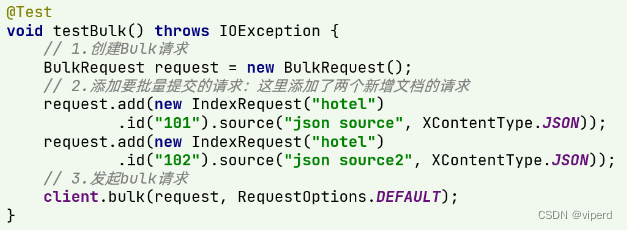1. RestClient
ES官方提供了各种不同语言的客户端,用来操作ES。这些客户端的本质就是组装DSL语句,通过http请求发送给ES。官方文档地址:Elasticsearch Clients | Elastic
其中的Java Rest Client又包括两种:
-
Java Low Level Rest Client
-
Java High Level Rest Client
1.1.创建一个项目
项目结构如下:

1.2. mapping映射
创建索引库,最关键的是mapping映射,而mapping映射要考虑的信息包括:
-
字段名
-
字段数据类型
-
是否参与搜索
-
是否需要分词
-
如果分词,分词器是什么?
其中:
-
字段名、字段数据类型,可以参考数据表结构的名称和类型
-
是否参与搜索要分析业务来判断,例如图片地址,就无需参与搜索
-
是否分词呢要看内容,内容如果是一个整体就无需分词,反之则要分词
-
分词器,我们可以统一使用ik_max_word
来看下酒店数据的索引库结构:
PUT /hotel
{
"mappings": {
"properties": {
"id": {
"type": "keyword"
},
"name":{
"type": "text",
"analyzer": "ik_max_word",
"copy_to": "all"
},
"address":{
"type": "keyword",
"index": false
},
"price":{
"type": "integer"
},
"score":{
"type": "integer"
},
"brand":{
"type": "keyword",
"copy_to": "all"
},
"city":{
"type": "keyword",
"copy_to": "all"
},
"starName":{
"type": "keyword"
},
"business":{
"type": "keyword"
},
"location":{
"type": "geo_point"
},
"pic":{
"type": "keyword",
"index": false
},
"all":{
"type": "text",
"analyzer": "ik_max_word"
}
}
}
}几个特殊字段说明:
-
location:地理坐标,里面包含精度、纬度
-
all:一个组合字段,其目的是将多字段的值 利用copy_to合并,提供给用户搜索
地理坐标说明:

copy_to说明:

1.3. 初始化RestClient
在elasticsearch提供的API中,与elasticsearch一切交互都封装在一个名为RestHighLevelClient的类中,必须先完成这个对象的初始化,建立与elasticsearch的连接。
分为三步:
1.3.1. 引入es的RestHighLevelClient依赖:
<dependency>
<groupId>org.elasticsearch.client</groupId>
<artifactId>elasticsearch-rest-high-level-client</artifactId>
</dependency>1.3.2. 因为SpringBoot默认的ES版本是7.6.2,所以我们需要覆盖默认的ES版本
<properties>
<java.version>1.8</java.version>
<elasticsearch.version>7.12.1</elasticsearch.version>
</properties>1.3.3. 初始化RestHgihLevelClient:
代码如下:
public class HotelIndexTest {
private RestHighLevelClient client;
@BeforeEach
void setUp() {
this.client = new RestHighLevelClient(RestClient.builder(
HttpHost.create("http://192.168.150.101:9200")
));
}
@AfterEach
void tearDown() throws IOException {
this.client.close();
}
}2. RestClient操作索引
2.1. 创建索引库
创建索引库的API如下:

代码分为三步:
-
1)创建Request对象。因为是创建索引库的操作,因此Request是CreateIndexRequest。
-
2)添加请求参数,其实就是DSL的JSON参数部分。因为json字符串很长,这里是定义了静态字符串常量MAPPING_TEMPLATE,让代码看起来更加优雅。
-
3)发送请求,client.indices()方法的返回值是IndicesClient类型,封装了所有与索引库操作有关的方法。
完整示例:
在hotel-demo的cn.itcast.hotel.constants包下,创建一个类,定义mapping映射的JSON字符串常量:
public class HotelConstants {
public static final String MAPPING_TEMPLATE = "{\n" +
" \"mappings\": {\n" +
" \"properties\": {\n" +
" \"id\": {\n" +
" \"type\": \"keyword\"\n" +
" },\n" +
" \"name\":{\n" +
" \"type\": \"text\",\n" +
" \"analyzer\": \"ik_max_word\",\n" +
" \"copy_to\": \"all\"\n" +
" },\n" +
" \"address\":{\n" +
" \"type\": \"keyword\",\n" +
" \"index\": false\n" +
" },\n" +
" \"price\":{\n" +
" \"type\": \"integer\"\n" +
" },\n" +
" \"score\":{\n" +
" \"type\": \"integer\"\n" +
" },\n" +
" \"brand\":{\n" +
" \"type\": \"keyword\",\n" +
" \"copy_to\": \"all\"\n" +
" },\n" +
" \"city\":{\n" +
" \"type\": \"keyword\",\n" +
" \"copy_to\": \"all\"\n" +
" },\n" +
" \"starName\":{\n" +
" \"type\": \"keyword\"\n" +
" },\n" +
" \"business\":{\n" +
" \"type\": \"keyword\"\n" +
" },\n" +
" \"location\":{\n" +
" \"type\": \"geo_point\"\n" +
" },\n" +
" \"pic\":{\n" +
" \"type\": \"keyword\",\n" +
" \"index\": false\n" +
" },\n" +
" \"all\":{\n" +
" \"type\": \"text\",\n" +
" \"analyzer\": \"ik_max_word\"\n" +
" }\n" +
" }\n" +
" }\n" +
"}";
}在hotel-demo中的HotelIndexTest测试类中,编写单元测试,实现创建索引:
@Test
void testCreateHotelIndex() throws IOException{
//1.创建request对象
CreateIndexRequest request = new CreateIndexRequest("hotel");
//2.准备请求的参数:DSL语句
request.source(MAPPING_TEMPLATE,XContentType.JSON);
//3.发送请求
client.indices().create(request,RequestOptions.DEFAULT);
}2.2. 删除索引库
删除索引库的DSL语句非常简单:
xxxxxxxxxx DELETE /hotel与创建索引库相比:
-
请求方式从PUT变为DELTE
-
请求路径不变
-
无请求参数
所以代码的差异,注意体现在Request对象上。依然是三步走:
-
1)创建Request对象。这次是DeleteIndexRequest对象
-
2)准备参数。这里是无参
-
3)发送请求。改用delete方法
在hotel-demo中的HotelIndexTest测试类中,编写单元测试,实现删除索引:
@Test
void DeleteHotelIndex() throws IOException{
//1.创建request对象
DeleteIndexRequest request = new DeleteIndexRequest("hotel");
//2.发送请求
client.indices().delete(request,RequestOptions.DEFAULT);
}2.3. 判断索引库是否存在
本质就是查询,对应的DSL语句是:
GET /hotel因此与删除的Java代码流程是类似的。依然是三步走:
-
1)创建Request对象。这次是GetIndexRequest对象
-
2)准备参数。这里是无参
-
3)发送请求。改用exists方法
@Test
void testExistsIndex() throws IOException{
//1.创建request对象
GetIndexRequest request = new GetIndexRequest("hotel");
//2.发起请求
boolean exists = client.indices().exists(request,RequestOptions.DEFAULT);
//3.输出
System.out.println(exists ? "hotel索引存在" : "hotel索引不存在");
}2.4. 总结
JavaRestClient操作elasticsearch的流程基本类似。核心是client.indices()方法来获取索引库的操作对象。
索引库操作的基本步骤:
-
初始化RestHighLevelClient
-
创建XxxIndexRequest。XXX是Create、Get、Delete
-
准备DSL( Create时需要,其它是无参)
-
发送请求。调用RestHighLevelClient#indices().xxx()方法,xxx是create、exists、delete
3. RestClient操作文档
3.1. 新增文档
我们要将数据库的酒店数据查询出来,写入elasticsearch中。
3.1.1. 索引库实体类
数据库查询后的结果是一个Hotel类型的对象,结构如下:
@Data
@TableName("tb_hotel")
public class Hotel {
@TableId(type = IdType.INPUT)
private Long id;
private String name;
private String address;
private Integer price;
private Integer score;
private String brand;
private String city;
private String starName;
private String business;
private String longitude;
private String latitude;
private String pic;
}与我们的索引库结构存在差异:
-
longitude和latitude需要合并为location
因此,我们需要定义一个新的类型,与索引库结构吻合:
@Data
@NoArgsConstructor
public class HotelDoc {
private Long id;
private String name;
private String address;
private Integer price;
private Integer score;
private String brand;
private String city;
private String starName;
private String business;
private String location;
private String pic;
public HotelDoc(Hotel hotel) {
this.id = hotel.getId();
this.name = hotel.getName();
this.address = hotel.getAddress();
this.price = hotel.getPrice();
this.score = hotel.getScore();
this.brand = hotel.getBrand();
this.city = hotel.getCity();
this.starName = hotel.getStarName();
this.business = hotel.getBusiness();
this.location = hotel.getLatitude() + ", " + hotel.getLongitude();
this.pic = hotel.getPic();
}
}3.1.2. 语法说明
新增文档的DSL语句如下:
POST /{索引库名}/_doc/1
{
"name": "Jack",
"age": 21
}对应的java代码如图:

可以看到与创建索引库类似,同样是三步走:
-
1)创建Request对象
-
2)准备请求参数,也就是DSL中的JSON文档
-
3)发送请求
变化的地方在于,这里直接使用client.xxx()的API,不再需要client.indices()了。
3.1.3. 完整代码
我们导入酒店数据,基本流程一致,但是需要考虑几点变化:
-
酒店数据来自于数据库,我们需要先查询出来,得到hotel对象
-
hotel对象需要转为HotelDoc对象
-
HotelDoc需要序列化为json格式
因此,代码整体步骤如下:
-
1)根据id查询酒店数据Hotel
-
2)将Hotel封装为HotelDoc
-
3)将HotelDoc序列化为JSON
-
4)创建IndexRequest,指定索引库名和id
-
5)准备请求参数,也就是JSON文档
-
6)发送请求
在hotel-demo的HotelDocumentTest测试类中,编写单元测试:
@Test
void testAddDocument() throws IOException{
//1.根据id查询酒店数据
Hotel hotel = hotelservice.getById(61803L);
//2.把Hotel类型的转成HotelDoc类型
HotelDoc hoteldoc = new HotelDoc(hotel);
//3.将HotelDoc转为json
String json = JSON.toJSONString(hotelDoc);
//1.准备request对象
IndexRequest request = new IndexRequest("hotel").id(hotelDoc.getId().toString());
//2.准备JSON文档
request.source(json,XContentType.JSON);
//3.发送请求
client.index(request,RequestOptions.DEFAULT);
}3.2. 查询文档
3.2.1. 语法说明
查询的DSL语句如下:
GET /hotel/_doc/{id}非常简单,因此代码大概分两步:
-
准备Request对象
-
发送请求
不过查询的目的是得到结果,解析为HotelDoc,因此难点是结果的解析。完整代码如下:

可以看到,结果是一个JSON,其中文档放在一个_source属性中,因此解析就是拿到_source,反序列化为Java对象即可。
与之前类似,也是三步走:
-
1)准备Request对象。这次是查询,所以是GetRequest
-
2)发送请求,得到结果。因为是查询,这里调用client.get()方法
-
3)解析结果,就是对JSON做反序列化
3.2.2 完整代码
在hotel-demo的HotelDocumentTest测试类中,编写单元测试:
@Test
void testGetDocument() throws IOException{
//1.创建request对象
GetRequest request = new GetRequest("hotel","61803");
//2.发送请求,得到响应
GetResponse response = client.get(request,RequestOptions.DEFAULT);
//3.解析响应结果
String json = response.getSourceAsString();
HotelDoc hotelDoc = JSON.parseObject(json,HotelDoc.class);
System.out.println(hotelDoc);
}3.3. 删除文档
删除的DSL为是这样的:
DELETE /hotel/_doc/{id}与查询相比,仅仅是请求方式从DELETE变成GET,可以想象Java代码应该依然是三步走:
-
1)准备Request对象,因为是删除,这次是DeleteRequest对象。要指定索引库名和id
-
2)准备参数,无参
-
3)发送请求。因为是删除,所以是client.delete()方法
在hotel-demo的HotelDocumentTest测试类中,编写单元测试:
@Test
void testDeleteDocument() throws IOException {
// 1.准备Request
DeleteRequest request = new DeleteRequest("hotel", "61083");
// 2.发送请求
client.delete(request, RequestOptions.DEFAULT);
}3.4. 修改文档
3.4.1. 语法说明
修改文档有两种方式:
1.全量修改:本质是根据id删除,然后进行新增
2.增量修改:修改文档中指定的字段的值
在RestClient的API中,全量修改与新增的API完全一致,判断依据是ID:
-
如果新增时,ID已经存在,则修改
-
如果新增时,ID不存在,则新增
这里不再赘述,我们主要关注增量修改。
代码示例如图:

与之前类似,也是三步走:
-
1)准备Request对象。这次是修改,所以是UpdateRequest
-
2)准备参数。也就是JSON文档,里面包含要修改的字段
-
3)更新文档。这里调用client.update()方法
3.4.2. 完整代码
在hotel-demo的HotelDocumentTest测试类中,编写单元测试:
@Test
void testUpdateDocument() throws IOException{
//1.准备request
UpdateRequest request = new UpdateRequest("hotel","61083");
//2.准备参数
request.doc(
"price","699",
"starName", "四钻"
);
//3.发起请求
client.update(request,RequestOptions.DEFAULT);
}3.5. 批量导入文档
案例需求:利用BulkRequest批量将数据库数据导入到索引库中。
步骤如下:
-
利用mybatis-plus查询酒店数据
-
将查询到的酒店数据(Hotel)转换为文档类型数据(HotelDoc)
-
利用JavaRestClient中的BulkRequest批处理,实现批量新增文档
3.5.1.语法说明
批量处理BulkRequest,其本质就是将多个普通的CRUD请求组合在一起发送。
其中提供了一个add方法,用来添加其他请求:

可以看到,能添加的请求包括:
-
IndexRequest,也就是新增
-
UpdateRequest,也就是修改
-
DeleteRequest,也就是删除
因此Bulk中添加了多个IndexRequest,就是批量新增功能了。示例:

其实还是三步走:
-
1)创建Request对象。这里是BulkRequest
-
2)准备参数。批处理的参数,就是其它Request对象,这里就是多个IndexRequest
-
3)发起请求。这里是批处理,调用的方法为client.bulk()方法
我们在导入酒店数据时,将上述代码改造成for循环处理即可。
3.5.2. 完整代码
在hotel-demo的HotelDocumentTest测试类中,编写单元测试:
@Test
void testBulkRequest() throws IOException{
//批量查询数据
List<Hotel> hotels = hotelservice.list();
//1.创建request
BulkRequest request = new BulkRequest();
//2.准备参数,添加多个新增的request
for(Hotel hotel : hotels){
//2.1 转换为HotelDoc文档类型
HotelDoc hotelDoc = new HotelDoc(hotel);
//2.2 创建新增文档的Request对象
request.add(new IndexRequest("hotel")
.id(hotelDoc.getId().toString())
.source(JSON.toJSONString(hotelDoc),XContentType.JSON);
}
//3.发起请求
client.bulk(request,RequestOptions.DEFAULT);
}3.6. 小结
文档操作的基本步骤:
-
初始化RestHighLevelClient
-
创建XxxRequest。XXX是Index、Get、Update、Delete、Bulk
-
准备参数(Index、Update、Bulk时需要)
-
发送请求。调用RestHighLevelClient#.xxx()方法,xxx是index、get、update、delete、bulk
-
解析结果(Get时需要)






















 1323
1323











 被折叠的 条评论
为什么被折叠?
被折叠的 条评论
为什么被折叠?








